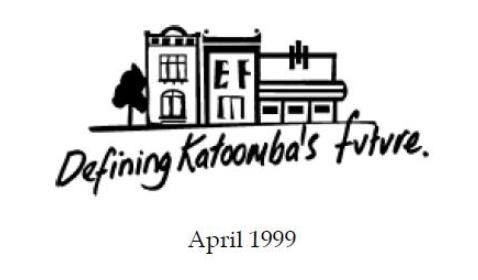Katoomba Charrette – Chapter 5: ‘Design Charrette’ Adaptation to Katoomba’s Town Centre

The ‘charrette’ methodology facilitates incremental creative project management was more recently adopted by urban design consulting firm Ecologically Sustainable Design Pty. Ltd (ESD) based outside New South Wales in North Fitzroy in Melbourne, Victoria. Since 1992 ESD had led some 15 charrette urban design methods across Australia and New Zealand.
In 1998, ESD was sourced and contracted by The Katoomba/Echo Point Planning Advisory Committee, probably out of generous funding put up by committed locals – businesses and residents alike. The ESD principals leading this town centre design project were Wendy Morris (as Charrette Leader) and Chip Kaufman (as Lead Urban Designer).
During the several months before the charrette, a Charrette Preparation Team was established comprised of the Blue Mountains City Council (the Client), NSW state government representatives and ESD.
ESD prepared a detailed Client’s Charrette Manual to guide the Client in its charrette preparation and management responsibilities. A rigorous assessment of existing and potential employment contexts and opportunities was also conducted prior to the Charrette. The Team also conducted extensive research to resolve unknown information determined to be needed to inform the charrette.
The information that was collected prior to the Charrette included:
- Extensive consultation with the local community, particularly through a household survey and a series of focus groups with interested parties;
- Collection of base environmental, social and economic information about Katoomba, particularly through a social profile completed by Council’s Cultural and Social Planning Branch, input from Council’s Environmental Management Branch and other expertise from across Council.
This information was presented in a briefing booklet that was used during the Charrette to identify and clarify issues. This Charrette Briefing Booklet became a crucial source of information that guided the Charrette. Details were found in the Appendix ‘Y’ of the Charrette document.
There was extensive public notice of the forthcoming charrette document, including weekly articles in the local paper, posting out of an information brochure to the residents of Katoomba, and discussions with local community groups.
During the preparation phase, ESD and committee considered Katoomba’s challenges and came up with the following objectives (read Chapter 6), which served as the ‘values’ which drove the Charrette outcomes.
“The main purpose of this document is to report the outcomes from the Katoomba Charrette and subsequent public submissions to Council, and to propose related strategies and action plans for Katoomba’s (urban design) revitalisation.”
The Katoomba Charrette
A Charrette is an intensive five day-long, design based, publicly-interactive planning and design process, held in a local venue, which is intended to resolve complex, large and / or controversial projects, such as town centre revitalisation activities.
In June 1999, Council adopted the “Katoomba Charrette Outcomes Report and Town Centre Revitalisation Strategy (1999)”. The strategy was developed as a result of the Katoomba Charrette conducted in October 1998 and provides a framework of actions and proposals for the revitalisation of the Katoomba Town Centre.
The proposals and actions included in the “Katoomba Charrette Outcomes Report and Town Centre Revitalisation Strategy” are covered in the following broad areas:
• Improving Katoomba Town Centre
• Improving transport and access
• Improving recreational, cultural and urban open space facilities
• Proposals for key sites
• Reviewing and reforming regulation to facilitate revitalisation
Realising the Vision for Katoomba
The Strategy, which has had the benefit of significant input from the community as a result of the Charrette process, provides a visionary framework to revitalise Katoomba. The program outlined in the Strategy will take a considerable number of years to implement through funding from state and local government, the private sector and through reviewing and reforming regulations to support the Charrette objectives.
The Charrette as a Framework to Guide Katoomba’s Revitalisation
The final recommendations in the Strategy emphasise that, despite the apparent clarity of many of the indicative Charrette designs, there are a number of ways to achieve the Charrette outcomes.
- Underlying circumstances of ownership and other redevelopment dynamics will change.
- Most development proposals will deviate, for one reason or another, from the indicative Charrette designs.
- Some will be better solutions than those of the Charrette.
- Some will respond to new or differently understood design and development criteria.
- The underlying principle is that each new proposal must contribute to Katoomba’s revitalisation.
